Roster: Company F, 47th Regiment, Pennsylvania Volunteers
History of Company F
1861-1862
Company F of the 47th Regiment, Pennsylvania Volunteer Infantry was the first company of this Union regiment to muster in for duty. The initial recruitment for members to staff F Company of the 47th Pennsylvania Volunteers was conducted in Catasauqua, Lehigh County, Pennsylvania.
Several of this company’s earliest recruits had, following the fall of Fort Sumter in April 1861, responded to President Abraham Lincoln’s call for 75,000 volunteers to help defend the nation’s capital. After completing their Three Months’ Service with Company D of the 9th Regiment, Pennsylvania Volunteer Infantry or other early responding Pennsylvania regiments, a contingent reenlisted from Catasauqua, joining the newly formed 47th Pennsylvania Volunteer Infantry as members of Company F in August of that same year.
However, a significant portion of service records for the men serving with this company indicate that many of those who enlisted with Company F were soldiers enlisting for military duty for the first time.
Company F officially mustered in for service at Camp Curtin in Harrisburg, Dauphin County from 13 to 30 August 1861, and was led by Captain Henry Samuel Harte. Born in 1822 in Darmstadt, capital of the Grand Duchy of Hesse (now Darmstadt, Hesse, Germany), Henry Harte had become a naturalized American citizen in New York on 15 October 1851, settled in Pennsylvania, been appointed Captain of the Lehigh County militia unit known as the Catasauqua Rifles during the late 1850s and, by the dawn of the Civil War, had also become a hotel keeper in Catasauqua.
Officially, Henry S. Harte enrolled for Civil War military service at Catasauqua on 21 August 1861, and was commissioned as a Captain. Mustered in on 30 August at Camp Curtin in Harrisburg, he was then placed in charge of Company F of the 47th Regiment, Pennsylvania Volunteer Infantry.
His obituary in the 10 August 1881 edition of The Allentown Democrat described his opening days as follows:
When the sound of the first gun roused the war spirit of the North to fever heat, he raised a company of volunteers and served as Captain of it with the 47th regiment Penna. Vols. for a full three year term, and it may be said that he along with the regiment saw as much hard service as any man in the army.
On 25 August, Private Emory Lindster, a druggist by trade, was promoted to the rank of Hospital Steward, and transferred to the regiment’s medical unit with the central command staff.
Following a brief training period in light infantry tactics at Camp Curtin, the remaining soldiers of Company F and their fellow members of the 47th Pennsylvania were transported south by rail to Washington, D.C. Stationed roughly two miles from the White House, they pitched their tents at “Camp Kalorama” on the Kalorama Heights near Georgetown beginning 21 September. Henry D. Wharton, a musician from the regiment’s C Company, penned an update the next day to the Sunbury American, his hometown newspaper:
After a tedious ride we have, at last, safely arrived at the City of ‘magnificent distances.’ We left Harrisburg on Friday last at 1 o’clock A.M. and reached this camp yesterday (Saturday) at 4 P.M., as tired and worn out a sett [sic] of mortals as can possibly exist. On arriving at Washington we were marched to the ‘Soldiers Retreat,’ a building purposely erected for the benefit of the soldier, where every comfort is extended to him and the wants of the ‘inner man’ supplied.
After partaking of refreshments we were ordered into line and marched, about three miles, to this camp. So tired were the men, that on marching out, some gave out, and had to leave the ranks, but J. Boulton Young, our ‘little Zouave,’ stood it bravely, and acted like a veteran. So small a drummer is scarcely seen in the army, and on the march through Washington he was twice the recipient of three cheers.
We were reviewed by Gen. McClellan yesterday [21 September 1861] without our knowing it. All along the march we noticed a considerable number of officers, both mounted and on foot; the horse of one of the officers was so beautiful that he was noticed by the whole regiment, in fact, so wrapt [sic] up were they in the horse, the rider wasn’t noticed, and the boys were considerably mortified this morning on dis-covering they had missed the sight of, and the neglect of not saluting the soldier next in command to Gen. Scott.
Col. Good, who has command of our regiment, is an excellent man and a splendid soldier. He is a man of very few words, and is continually attending to his duties and the wants of the Regiment.
…. Our Regiment will now be put to hard work; such as drilling and the usual business of camp life, and the boys expect and hope an occasional ‘pop’ at the enemy.
While at Camp Kalorama, Captain Harte issued his first directive (Company Order No. 1), that his company drill four times per day, each time for one hour.
On 24 September, the 47th Regiment, Pennsylvania Volunteer Infantry finally became part of the U.S. Army when its men were officially mustered into federal service. On 27 September—a rainy day, the 47th Pennsylvania was assigned to the 3rd Brigade of Brigadier-General Isaac Stevens, which also included the 33rd, 49th and 79th New York regiments. By that afternoon, the 47th Pennsylvania was on the move again.
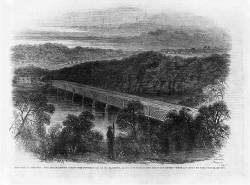
Chain Bridge across the Potomac above Georgetown looking toward Virginia, 1861 (The Illustrated London News, public domain).
Ordered onward by Brigadier-General Silas Casey, the 47th Pennsylvanians marched behind their regimental band until reaching Camp Lyon, Maryland on the Potomac River’s eastern shore. At 5 p.m., they joined the 46th Pennsylvania in moving double-quick (one hundred and sixty-five steps per minute using thirty-three-inch steps) across the “Chain Bridge” marked on federal maps, and continued on for roughly another mile before being ordered to make camp.
The next morning, they broke camp and moved again. Marching toward Falls Church, Virginia, they arrived at Camp Advance around dusk. There, about two miles from the bridge they had crossed a day earlier, they re-pitched their tents in a deep ravine near a new federal fort under construction (Fort Ethan Allen). Having completed a roughly eight-mile trek, they were now situated near the headquarters of Brigadier-General William Farrar Smith (nicknamed “Baldy”), the commander of the Union’s massive Army of the Potomac (“Mr. Lincoln’s Army”). Armed with Mississippi rifles supplied by the Keystone State, their job was to help defend the nation’s capital. Under Smith’s leadership, their regiment and brigade would help to defend the nation’s capital from the time of their September arrival through late January 1862 when the men of the 47th Pennsylvania would be shipped south.
Once again, Company C Musician Henry Wharton recapped the regiment’s activities, noting, via his 29 September letter home to the Sunbury American, that the 47th had changed camps three times in three days:
On Friday last we left Camp Kalorama, and the same night encamped about one mile from the Chain Bridge on the opposite side of the Potomac from Washington. The next morning, Saturday, we were ordered to this Camp [Camp Advance near Fort Ethan Allen, Virginia], one and a half miles from the one we occupied the night previous. I should have mentioned that we halted on a high hill (on our march here) at the Chain Bridge, called Camp Lyon, but were immediately ordered on this side of the river. On the route from Kalorama we were for two hours exposed to the hardest rain I ever experienced. Whew, it was a whopper; but the fellows stood it well – not a murmur – and they waited in their wet clothes until nine o’clock at night for their supper. Our Camp adjoins that of the N.Y. 79th (Highlanders.)….
We had not been in this Camp more than six hours before our boys were supplied with twenty rounds of ball and cartridge, and ordered to march and meet the enemy; they were out all night and got back to Camp at nine o’clock this morning, without having a fight. They are now in their tents taking a snooze preparatory to another march this morning…. I don’t know how long the boys will be gone, but the orders are to cook two days’ rations and take it with them in their haversacks….
There was a nice little affair came off at Lavensville [sic], a few miles from here on Wednesday last; our troops surprised a party of rebels (much larger than our own.) killing ten, took a Major prisoner, and captured a large number of horses, sheep and cattle, besides a large quantity of corn and potatoes, and about ninety six tons of hay. A very nice day’s work. The boys are well, in fact, there is no sickness of any consequence at all in our Regiment….
On 1 October 1861, Sergeant James W. (J. W.) Fuller, Jr. was promoted to the rank of First Lieutenant and Regimental Adjutant with the regiment’s central command staff, a position he held for just over three months—until 9 January 1862 when he resigned.
Sometime during this phase of duty, as part of the 3rd Brigade, the 47th Pennsylvanians were moved to a site they initially christened “Camp Big Chestnut” in reference to the large chestnut tree located within their lodging’s boundaries. The site would eventually become known to the Keystone Staters as “Camp Griffin,” and was located roughly 10 miles from Washington, D.C.
On 11 October, the 47th Pennsylvania Volunteers marched in the Grand Review at Bailey’s Cross Roads. In a mid-October letter home, Captain John Peter Shindel Gobin (the leader of C Company who would be promoted in 1864 to lead the entire 47th Regiment) reported that companies D, A, C, F and I (the 47th Pennsylvania’s right wing) were ordered to picket duty after the left-wing companies (B, G, K, E, and H) had been forced to return to camp by Confederate troops. In his letter of 13 October, Henry Wharton described their duties, as well as their new home:
The location of our camp is fine and the scenery would be splendid if the view was not obstructed by heavy thickets of pine and innumerable chesnut [sic] trees. The country around us is excellent for the Rebel scouts to display their bravery; that is, to lurk in the dense woods and pick off one of our unsuspecting pickets. Last night, however, they (the Rebels) calculated wide of their mark; some of the New York 33d boys were out on picket; some fourteen or fifteen shots were exchanged, when our side succeeded in bringing to the dust, (or rather mud,) an officer and two privates of the enemy’s mounted pickets. The officer was shot by a Lieutenant in Company H [?], of the 33d.
Our own boys have seen hard service since we have been on the ‘sacred soil.’ One day and night on picket, next day working on entrenchments at the Fort, (Ethan Allen.) another on guard, next on march and so on continually, but the hardest was on picket from last Thursday morning ‘till Saturday morning – all the time four miles from camp, and both of the nights the rain poured in torrents, so much so that their clothes were completely saturated with the rain. They stood it nobly – not one complaining; but from the size of their haversacks on their return, it is no wonder that they were satisfied and are so eager to go again tomorrow. I heard one of them say ‘there was such nice cabbage, sweet and Irish potatoes, turnips, &c., out where their duty called them, and then there was a likelihood of a Rebel sheep or young porker advancing over our lines and then he could take them as ‘contraband’ and have them for his own use.’ When they were out they saw about a dozen of the Rebel cavalry and would have had a bout with them, had it not been for…unlucky circumstance – one of the men caught the hammer of his rifle in the strap of his knapsack and caused his gun to fire; the Rebels heard the report and scampered in quick time….
On Friday morning, 22 October 1861, the 47th engaged in a Divisional Review, described by Schmidt as massing “about 10,000 infantry, 1000 cavalry, and twenty pieces of artillery all in one big open field.” Less than a month later, in his letter of 17 November, Henry Wharton revealed more details about life at Camp Griffin:
This morning our brigade was out for inspection; arms, accoutrements [sic], clothing, knapsacks, etc, all were out through a thorough examination, and if I must say it myself, our company stood best, A No. 1, for cleanliness. We have a new commander to our Brigade, Brigadier General Brannen [sic], of the U.S. Army, and if looks are any criterion, I think he is a strict disciplinarian and one who will be as able to get his men out of danger as he is willing to lead them to battle….
The boys have plenty of work to do, such as piquet [sic] duty, standing guard, wood-chopping, police duty and day drill; but then they have the most substantial food; our rations consist of fresh beef (three times a week) pickled pork, pickled beef, smoked pork, fresh bread, daily, which is baked by our own bakers, the Quartermaster having procured portable ovens for that purpose, potatoes, split peas, beans, occasionally molasses and plenty of good coffee, so you see Uncle Sam supplies us plentifully….
A few nights ago our Company was out on piquet [sic]; it was a terrible night, raining very hard the whole night, and what made it worse, the boys had to stand well to their work and dare not leave to look for shelter. Some of them consider they are well paid for their exposure, as they captured two ancient muskets belonging to Secessia. One of them is of English manufacture, and the other has the Virginia militia mark on it. They are both in a dilapidated condition, but the boys hold them in high estimation as they are trophies from the enemy, and besides they were taken from the house of Mrs. Stewart, sister to the rebel Jackson who assassinated the lamented Ellsworth at Alexandria. The honorable lady, Mrs. Stewart, is now a prisoner at Washington and her house is the headquarters of the command of the piquets [sic]….
Since the success of the secret expedition, we have all kinds of rumors in camp. One is that our Brigade will be sent to the relief of Gen. Sherman, in South Carolina. The boys all desire it and the news in the ‘Press’ is correct, that a large force is to be sent there, I think their wish will be gratified….
On 21 November, the 47th participated in a morning divisional headquarters review that was overseen by the regiment’s founder and commanding officer, Colonel Tilghman H. Good, followed by brigade and division drills all afternoon. According to Schmidt, “each man was supplied with ten blank cartridges.” Afterward, “Gen. Smith requested Gen. Brannan to inform Col. Good that the 47th was the best regiment in the whole division.”
As a reward for their performance—and in preparation for bigger things to come, Brigadier-General John Milton Brannan obtained brand new Springfield rifles for every member of the 47th Pennsylvania Volunteers. On 18 January 1862, Private Conrad Warnick was discharged on a Surgeon’s Certificate.
1862
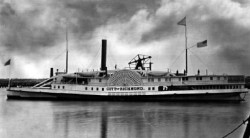
The City of Richmond, a sidewheel steamer that transported Union troops during the Civil War (Maine, circa late 1860s, public domain).
Next ordered to move from their Virginia encampment back to Maryland, the 47th Pennsylvania Volunteers left Camp Griffin at 8:30 a.m. on Wednesday, 22 January 1862. Marching through deep mud with their equipment for three miles in order to reach the railroad station at Falls Church, they were transported by rail to Alexandria, Virginia, where they boarded the steamship City of Richmond, and sailed the Potomac to the Washington Arsenal. Reequipped there, they were then marched off for dinner and rest at the Soldiers’ Retreat in Washington, D.C.
The next afternoon, the 47th Pennsylvanians hopped cars on the Baltimore & Ohio Railroad, and headed for Annapolis, Maryland. Arriving around 10 p.m., they were assigned quarters in barracks at the Naval Academy. They then spent that Friday through Monday (24-27 January 1862) loading their equipment and other supplies onto the steamship Oriental.
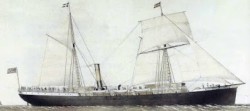
The 47th Pennsylvania Volunteers were transported to Florida aboard the steamship U.S. Oriental in January 1862 (public domain).
According to Schmidt and letters home from members of the regiment, those preparations ceased on Monday, 27 January, at 10 a.m. when:
The regiment was formed and instructed by Lt. Col. Alexander ‘that we were about drumming out a member who had behaved himself unlike a soldier.’ …. The prisoner, Pvt. James C. Robinson of Company I, was a 36 year old miner from Allentown who had been ‘disgracefully discharged’ by order of the War Department. Pvt. Robinson was marched out with martial music playing and a guard of nine men, two men on each side and five behind him at charge bayonets. The music then struck up with ‘Robinson Crusoe’ as the procession was marched up and down in front of the regiment, and Pvt. Robinson was marched out of the yard.
Reloading then resumed. By that afternoon, when the 47th Pennsylvania Volunteers commenced boarding the Oriental, they were ferried to the big steamship by smaller steamers. The officers boarded last and, per the directive of Brigadier-General Brannan, the Oriental steamed away for the Deep South at 4 p.m. They were headed for Florida which, despite its secession from the Union, remained strategically important to the Union due to the presence of Forts Taylor and Jefferson in Key West and the Dry Tortugas.

Alfred Waud’s 1862 sketch of Fort Taylor and Key West, Florida (U.S. Library of Congress, public domain; click to enlarge).
The members of Company F arrived in Key West in early 1862, and were assigned, with their fellow members of the regiment, to garrison Fort Taylor. During the weekend of Friday, 14 February, the 47th Pennsylvanians introduced their presence to Key West residents as the regiment paraded through the streets of the city. That Sunday, soldiers from the 47th Pennsylvania also mingled with locals by attending services at area churches.
Drilling daily in heavy artillery tactics, they also strengthened the fortifications at this federal installation. On 1 April 1862, Sergeant Augustus Eagle was promoted to the rank of Second Lieutenant.
In addition to their exhausting military duties, the 47th Pennsylvanians also encountered a persistent and formidable foe—disease. Several members of the regiment fell ill, largely due to poor sanitary conditions and water quality. As a result, Privates W. H. Moyer, II and Frederick Eagle were discharged on Surgeons’ Certificates of Disability on 4 March and 14 March 1862, respectively, and Second Lieutenant Henry H. Bush and Private Edward Bartholomew died at Fort Taylor, respectively, on 31 March and 3 April. Privates Samuel Smith and John G. Seider were then also both discharged on Surgeons’ Certificates on 12 April 1862.
But there were lighter moments as well.
According to a letter penned by Henry Wharton on 27 February 1862, the regiment commemorated the birthday of former U.S. President George Washington with a parade, a special ceremony involving the reading of Washington’s farewell address to the nation (first delivered in 1796), the firing of cannon at the fort, and a sack race and other games on 22 February. The festivities resumed two days later when the 47th Pennsylvania’s Regimental Band hosted an officers’ ball at which “all parties enjoyed themselves, for three o’clock of the morning sounded on their ears before any motion was made to move homewards.” This was then followed by a concert by the Regimental Band on Wednesday evening, 26 February.
According to Schmidt, 4 June 1862 was also a festive day for the regiment. As the USS Niagara sailed for Boston after transferring its responsibilities as the flagship of the Union Navy squadron in that sector to the USS Potomac, the guns of fifteen warships anchored nearby fired a salute, as did the 47th Pennsylvania Volunteers. Captain Harte and F Company played a prominent role in the day’s events as they “fired 15 of the heavy casemate guns from Fort Taylor at 4 PM.”
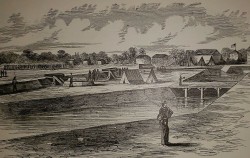
Fort Walker, Hilton Head, South Carolina, circa 1861 (Frank Leslie’s Illustrated Newspaper, public domain).
Next ordered to Hilton Head, South Carolina from mid-June through July, the 47th Pennsylvanians camped near Fort Walker before relocating to the Beaufort District, Department of the South, roughly thirty-five miles away. Frequently assigned to hazardous picket detail north of their main camp, which put them at increased risk from enemy sniper fire, the members of the 47th Pennsylvania became known for their “attention to duty, discipline and soldierly bearing,” and “received the highest commendation from Generals Hunter and Brannan,” according to historian Samuel P. Bates.
Detachments from the regiment were also assigned to the Expedition to Fenwick Island (9 July) and the Demonstration against Pocotaligo (10 July).
During the second week of July, according to Schmidt, Major William H. Gausler and Captain Henry S. Harte returned home to the Lehigh Valley to resume their recruiting efforts. After arriving in Allentown on 15 July, they quickly re-established an efficient operation, which they would keep running through early November 1862. During this time, Major Gausler was able to persuade fifty-four new recruits to join the 47th Pennsylvania while Harte rounded up an additional twelve.
Meanwhile, back in the Deep South, Captain Harte’s F Company men were commanded by Harte’s direct subordinates, First Lieutenant George W. Fuller and Second Lieutenant August G. Eagle.
On 12 September, Colonel Tilghman Good and his adjutant, First Lieutenant Washington H. R. Hangen, issued Regimental Order No. 207 from the 47th Pennsylvania’s Headquarters in Beaufort, South Carolina:
I. The Colonel commanding desires to call the attention of all officers and men in the regiment to the paramount necessity of observing rules for the preservation of health. There is less to be apprehended from battle than disease. The records of all companies in climate like this show many more casualties by the neglect of sanitary post action then [sic] by the skill, ordnance and courage of the enemy. Anxious that the men in my command may be preserved in the full enjoyment of health to the service of the Union. And that only those who can leave behind the proud epitaph of having fallen on the field of battle in the defense of their country shall fail to return to their families and relations at the termination of this war.
II. All the tents will be struck at 7:30 a.m. on Monday, Wednesday and Saturday of each week. The signal for this purpose will be given by the drum major by giving three taps on the drum. Every article of clothing and bedding will be taken out and aired; the flooring and bunks will be thoroughly cleaned. By the same signal at 11 a.m. the tents will be re-erected. On the days the tents are not struck the sides will be raised during the day for the purpose of ventilation.
III. The proper cooking of provisions is a matter of great importance more especially in this climate but have not yet received from a majority of officers of the regiment that attention that should be paid to it.
IV. Thereafter an officer of each company will be detailed by the commander of each company and have their names reported to these headquarters to superintend the cooking of provisions taking care that all food prepared for the soldiers is sufficiently cooked and that the meats are all boiled or seared (not fried). He will also have charge of the dress table and he is held responsible for the cleanliness of the kitchen cooking utensils and the preparation of the meals at the time appointed.
V. The following rules for the taking of meals and regulations in regard to the conducting of the company will be strictly followed. Every soldier will turn his plate, cup, knife and fork into the Quarter Master Sgt who will designate a permanent place or spot each member of the company and there leave his plate & cup, knife and fork placed at each meal with the soldier’s rations on it. Nor will any soldier be permitted to go to the company kitchen and take away food therefrom.
VI. Until further orders the following times for taking meals will be followed Breakfast at six, dinner at twelve, supper at six. The drum major will beat a designated call fifteen minutes before the specified time which will be the signal to prepare the tables, and at the time specified for the taking of meals he will beat the dinner call. The soldier will be permitted to take his spot at the table before the last call.
VII. Commanders of companies will see that this order is entered in their company order book and that it is read forth with each day on the company parade. All commanding officers of companies will regulate daily their time by the time of this headquarters. They will send their 1st Sergeants to this headquarters daily at 8 a.m. for this purpose.
Great punctuality is enjoined in conforming to the stated hours prescribed by the roll calls, parades, drills, and taking of meals; review of army regulations while attending all roll calls to be suspended by a commissioned officer of the companies, and a Captain to report the alternate to the Colonel or the commanding officer.
At 5 a.m., Commanders of companies are imperatively instructed to have the company quarters washed and policed and secured immediately after breakfast.
At 6 a.m., morning reports of companies request [sic] by the Captains and 1st Sgts and all applications for special privileges of soldiers must be handed to the Adjutant before 8 a.m.
By Command of Col. T. H. Good
W. H. R. Hangen Adj
In addition, First Lieutenant and Regimental Adjutant Hangen clarified the regiment’s schedule as follows:
- Reveille (5:30 a.m.) and Breakfast (6:00 a.m.)
- First and Second Calls for Guard (6:10 a.m. and 6:15 a.m.)
- Surgeon’s Call (6:30 a.m.)
- First and Second Calls for Company Drill (6:45 a.m. and 7:00 a.m.)
- Recall from Company Drill (8:00 a.m.)
- First and Second Calls for Squad Drill (9:00 a.m. and 9:15 a.m.)
- Recall from Squad Drill (10:30 a.m.) and Dinner (12:00 noon)
- Call for Non-commissioned Officers (1:30 p.m.)
- Recall for Non-commissioned Officers (2:30 p.m.)
- First and Second Calls for Squad Drills (3:15 p.m. and 3:30 p.m.)
- Recall from Squad Drill (4:30 p.m.)
- First and Second Calls for Dress Parade (5:10 p.m. and 5:15 p.m.)
- Supper (6:10 p.m.)
- Tattoo (9:00 p.m.) and Taps (9:15 p.m.)
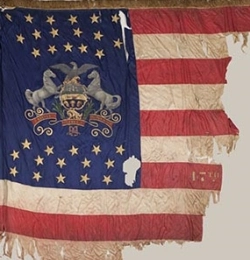
First State Color, 47th Regiment, Pennsylvania Volunteer Infantry (presented to the regiment by Pennsylvania Governor Andrew Curtin, 20 September 1861; retired 11 May 1865, public domain).
As the one-year anniversary of the 47th Pennsylvania’s departure from the Great Keystone State dawned on 20 September, thoughts turned to home and Divine Providence as Colonel Tilghman Good issued Special Order No. 60 from the 47th’s Regimental Headquarters in Beaufort, South Carolina:
The Colonel commanding takes great pleasure in complimenting the officers and men of the regiment on the favorable auspices of today.
Just one year ago today, the organization of the regiment was completed to enter into the service of our beloved country, to uphold the same flag under which our forefathers fought, bled, and died, and perpetuate the same free institutions which they handed down to us unimpaired.
It is becoming therefore for us to rejoice on this first anniversary of our regimental history and to show forth devout gratitude to God for this special guardianship over us.
Whilst many other regiments who swelled the ranks of the Union Army even at a later date than the 47th have since been greatly reduced by sickness or almost cut to pieces on the field of battle, we as yet have an entire regiment and have lost but comparatively few out of our ranks.
Certain it is we have never evaded or shrunk from duty or danger, on the contrary, we have been ever anxious and ready to occupy any fort, or assume any position assigned to us in the great battle for the constitution and the Union.
We have braved the danger of land and sea, climate and disease, for our glorious cause, and it is with no ordinary degree of pleasure that the Colonel compliments the officers of the regiment for the faithfulness at their respective posts of duty and their uniform and gentlemanly manner towards one another.
Whilst in numerous other regiments there has been more or less jammings and quarrelling [sic] among the officers who thus have brought reproach upon themselves and their regiments, we have had none of this, and everything has moved along smoothly and harmoniously. We also compliment the men in the ranks for their soldierly bearing, efficiency in drill, and tidy and cleanly appearance, and if at any time it has seemed to be harsh and rigid in discipline, let the men ponder for a moment and they will see for themselves that it has been for their own good.
To the enforcement of law and order and discipline it is due our far fame as a regiment and the reputation we have won throughout the land.
With you he has shared the same trials and encountered the same dangers. We have mutually suffered from the same cold in Virginia and burned by the same southern sun in Florida and South Carolina, and he assures the officers and men of the regiment that as long as the present war continues, and the service of the regiment is required, so long he stands by them through storm and sunshine, sharing the same danger and awaiting the same glory.
A Regiment Victorious — and Bloodied
During a return expedition to Florida beginning 30 September, the 47th joined with the 1st Connecticut Battery, 7th Connecticut Infantry, and part of the 1st Massachusetts Cavalry in assaulting Confederate forces at their heavily protected camp at Saint John’s Bluff overlooking the Saint John’s River area. Trekking and skirmishing through roughly twenty-five miles of dense swampland and forests after disembarking from ships at Mayport Mills on 1 October, the 47th captured artillery and ammunition stores (on 3 October) that had been abandoned by Confederate forces during the bluff’s bombardment by Union gunboats.
Note: The capture of Saint John’s Bluff followed a string of U.S. Army and Navy successes which enabled the Union to gain control over key southern towns and transportation hubs. In November 1861, the Union’s South Atlantic Blockading Squadron established an operations base at Port Royal, South Carolina, facilitating Union expeditions to Georgia and Florida, during which U.S. troops were able to take possession of Fort Clinch and Fernandina, Florida (3-4 March 1862), secure the surrender of Fort Marion and Saint Augustine (11 March), and establish a Union Navy base at Mayport Mills (mid-March). That summer, Brigadier-General Joseph Finnegan, commanding officer of the Confederate States of America’s Department of Middle and Eastern Florida, ordered the placement of earthen works-fortified gun batteries atop Saint John’s Bluff overlooking the Saint John’s River and at Yellow Bluff nearby. Confederate leaders hoped to disable the Union’s naval and ground force operations at and beyond Mayport Mills with as many as eighteen cannon, including three eight-inch siege howitzers and eight-inch smoothbores and Columbiads (two of each).
After the U.S. gunboats Uncas and Patroon exchanged shell-fire with the Confederate battery at Saint John’s Bluff on 11 September, Rebel troops were initially driven away, but then returned to their battery on the bluff. When a second, larger Union gunboat flotilla tried and failed again six days later to shake the Confederates loose, Union military leaders ordered an army operation with naval support.
Backed by U.S. gunboats Cimarron, E.B. Hale, Paul Jones, Uncas and Water Witch armed with twelve-pound boat howitzers, the 1,500-strong Union Army force commanded by Brigadier-General Brannan moved up the Saint John’s River and further inland along the Pablo and Mt. Pleasant Creeks on 1 October 1862 before disembarking and marching for the battery atop Saint John’s Bluff. The next day, Union gunboats exchanged shellfire with the Rebel battery while the Union ground force continued its advance. When the 47th Pennsylvanians reached Saint John’s Bluff with their fellow Union brigade members on 3 October 1862, they found the battery abandoned. (Other Union troops discovered that the Yellow Bluff battery was also Rebel free.)
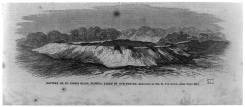
Earthworks around the Confederate battery atop Saint John’s Bluff, overlooking the Saint John’s River in Florida, 1862 (J. H. Schell, public domain).
In his report on the matter, filed from Mount Pleasant Landing, Florida on 2 October 1862, Colonel Tilghman H. Good described the Union Army’s assault on Saint John’s Bluff:
In accordance with orders received I landed my regiment on the bank of Buckhorn Creek at 7 o’clock yesterday morning. After landing I moved forward in the direction of Parkers plantation, about 1 mile, being then within about 14 miles of said plantation. Here I halted to await the arrival of the Seventh Connecticut Regiment. I advanced two companies of skirmishers toward the house, with instructions to halt in case of meeting any of the enemy and report the fact to me. After they had advanced about three-quarters of a mile they halted and reported some of the enemy ahead. I immediately went forward to the line and saw some 5 or 6 mounted men about 700 or 800 yards ahead. I then ascended a tree, so that I might have a distinct view of the house and from this elevated position I distinctly saw one company of infantry close by the house, which I supposed to number about 30 or 40 men, and also some 60 or 70 mounted men. After waiting for the arrival of the Seventh Connecticut Volunteers until 10 o’clock, and it not appearing, I dispatched a squad of men back to the landing for a 6-pounder field howitzer which had been kindly offered to my service by Lieutenant Boutelle, of the Paul Jones. This howitzer had been stationed on a flat-boat to protect our landing. The party, however, did not arrive with the piece until 12 o’clock, in consequence of the difficulty of dragging it through the swamp. Being anxious to have as little delay as possible, I did not await the arrival of the howitzer, but at 11 a.m. moved forward, and as I advanced the enemy fled.
After reaching the house I awaited the arrival of the Seventh Connecticut and the howitzer. After they arrived I moved forward to the head of Mount Pleasant Creek to a bridge, at which place I arrived at 2 p.m. Here I found the bridge destroyed, but which I had repaired in a short time. I then crossed it and moved down on the south bank toward Mount Pleasant Landing. After moving about 1 mile down the bank of the creek my skirmishing companies came upon a camp, which evidently had been very hastily evacuated, from the fact that the occupants had left a table standing with a sumptuous meal already prepared for eating. On the center of the table was placed a fine, large meat pie still warm, from which one of the party had already served his plate. The skirmishers also saw 3 mounted men leave the place in hot haste. I also found a small quantity of commissary and quartermasters stores, with 23 tents, which, for want of transportation, I was obliged to destroy. After moving about a mile farther on I came across another camp, which also indicated the same sudden evacuation. In it I found the following articles … breech-loading carbines, 12 double-barreled shot-guns, 8 breech-loading Maynard rifles, 11 Enfield rifles, and 96 knapsacks. These articles I brought along by having the men carry them. There were, besides, a small quantity of commissary and quartermasters stores, including 16 tents, which, for the same reason as stated, I ordered to be destroyed. I then pushed forward to the landing, where I arrived at 7 p.m.
We drove the enemys [sic] skirmishers in small parties along the entire march. The march was a difficult one, in consequence of meeting so many swamps almost knee-deep.
On 3 October, Good then filed this report from Saint John’s Bluff, Florida, now in Union hands:
At 9 o’clock last night Lieutenant Cannon reported to me that his command, consisting of one section of the First Connecticut Battery, was then coming up the creek on flat-boats with a view of landing. At 4 o’clock this morning a safe landing was effected and the command was ready to move. The order to move to Saint John’s Bluff reached me at 4 p.m. yesterday. In accordance with it I put the column in motion immediately and moved cautiously up the bank of the Saint John’s River, the skirmishing companies occasionally seeing small parties of the enemy’s cavalry retiring in our front as we advanced. When about 2 miles from the bluff the left wing of the skirmishing line came upon another camp of the enemy, which, however, in consequence of the lateness of the hour, I did not take time to examine, it being then already dark.
After my arrival at the bluff, it then being 7:30 o’clock, I dispatched Lieutenant-Colonel Alexander with two companies back to the last-named camp (which I found, from a number of papers left behind, to have been called Camp Hopkins and occupied by the Milton Artillery, of Florida) to reconnoiter and ascertain its condition. Upon his return he reported that from every appearance the skedaddling of the enemy was as sudden as in the other instances already mentioned, leaving their trunks and all the camp equipage behind; also a small store of commissary supplies, sugar, rice, half barrel of flour, one bag of salt, &c., including 60 tents which I have brought in this morning. The commissary stores were used by the troops of my command.
With those successes, Union leaders ordered the gunboats and army troops to extend the expedition, which they did, capturing assorted watercraft as they advanced further up the river. During this phase, Companies E and K of the 47th were led by Captain Charles Yard (E Company’s captain) in capturing Jacksonville, Florida (5 October) and the Gov. Milton, a Confederate steamer. Docked near Hawkinsville, the Milton had been furnishing troops, ammunition and other supplies not only to the Rebel battery atop Saint John’s Bluff, but to other Confederate Army units scattered throughout the region.
Integration of the Regiment
On 5 and 15 October 1862, respectively, the 47th Pennsylvania then made history as it became an integrated regiment, adding to its muster rolls several young to middle-aged Black men who had endured plantation enslavement in Beaufort, South Carolina. Among the men freed who subsequently opted to enroll as members of the 47th Pennsylvania Volunteers were Abraham Jassum and Edward Jassum (aged sixteen and twenty-two, respectively), and Bristor Gethers (aged thirty-three), whose name was spelled as “Presto Gettes” on transcriptions of muster rolls made by historian Samuel P. Bates. More men of color would continue to be added to the 47th Pennsylvania’s rosters in the weeks and years to come.
Battle of Pocotaligo, South Carolina
From 21-23 October 1862, under the brigade and regimental commands of Colonel T. H. Good and Lieutenant-Colonel George W. Alexander, the 47th Pennsylvania Volunteers next engaged the heavily protected Confederate forces in and around Pocotaligo, South Carolina—including at Frampton’s Plantation and the Pocotaligo Bridge—a key piece of southern railroad infrastructure which Union leaders felt should be destroyed.
Harried by snipers en route to the Pocotaligo Bridge, they met resistance from an entrenched, heavily fortified Confederate battery which opened fire on the Union troops as they entered an open cotton field. Those headed toward higher ground at the Frampton Plantation fared no better as they encountered artillery and infantry fire from the surrounding forests. The Union soldiers grappled with Confederates where they found them, pursuing the Rebels for four miles as they retreated to the bridge. There, the 47th relieved the 7th Connecticut. But the enemy was just too well armed. After two hours of intense fighting in an attempt to take the ravine and bridge, depleted ammunition forced the 47th to withdraw to Mackay’s Point.
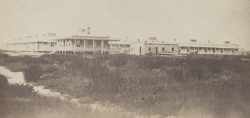
U.S. General Hospital, Hilton Head, South Carolina, facing ocean/Port Royal Bay (Broad River), medical director’s residence, left foreground, circa 1861-1865 (U.S. Library of Congress, public domain).
Losses for the 47th Pennsylvania were significant. Captain Charles Mickley of G Company was killed in action. Captain George Junker of Company K was mortally wounded, as was Private John O’Brien of Company F, who died on 26 October while being treated for his wounds at the Union Army’s hospital at Hilton Head, South Carolina.
Private Thomas A. Smith was discharged on a Surgeon’s Certificate on 14 December 1862. Private Peter Moser and Corporal Augustus Eberhart of F Company were wounded in action, and discharged respectively on Surgeons’ Certificates on 24 February and 13 April 1863.
In his report on the engagement, made from headquarters at Beaufort, South Carolina on 24 October 1862, Colonel Good wrote:
SIR: I have the honor to submit the following report of the part taken by the Forty-seventh Regiment Pennsylvania Volunteers in the action of October 22:
Eight companies, comprising 480 men, embarked on the steamship Ben De Ford, and two companies, of 120 men, on the Marblehead, at 2 p.m. October 21. With this force I arrived at Mackays Landing before daylight the following morning. At daylight I was ordered to disembark my regiment and move forward across the first causeway and take a position, and there await the arrival of the other forces. The two companies of my regiment on board of the Marblehead had not yet arrived, consequently I had but eight companies of my regiment with me at this juncture.
At 12 m. I was ordered to take the advance with four companies, one of the Forty-seventh and one of the Fifty-fifth Pennsylvania Volunteers, and two of the Sixth Connecticut, and to deploy two of them as skirmishers and move forward. After moving forward about 2 miles I discerned some 30 or 40 of the enemys [sic] cavalry ahead, but they fled as we advanced. About 2 miles farther on I discovered two pieces of artillery and some cavalry, occupying a position about three-quarters of a mile ahead in the road. I immediately called for a regiment, but seeing that the position was not a strong one I made a charge with the skirmishing line. The enemy, after firing a few rounds of shell, fled. I followed up as rapidly as possible to within about 1 mile of Frampton Creek. In front of this stream is a strip of woods about 500 yards wide, and in front of the woods a marsh of about 200 yards, with a small stream running through it parallel with the woods. A causeway also extends across the swamp, to the right of which the swamp is impassable. Here the enemy opened a terrible fire of shell from the rear, of the woods. I again called for a regiment, and my regiment came forward very promptly. I immediately deployed in line of battle and charged forward to the woods, three companies on the right and the other five on the left of the road. I moved forward in quick-time, and when within about 500 yards of the woods the enemy opened a galling fire of infantry from it. I ordered double-quick and raised a cheer, and with a grand yell the officers and men moved forward in splendid order and glorious determination, driving the enemy from this position.
On reaching the woods I halted and reorganized my line. The three companies on the right of the road (in consequence of not being able to get through the marsh) did not reach the woods, and were moved by Lieutenant-Colonel Alexander by the flank on the causeway. During this time a terrible fire of grape and canister was opened by the enemy through the woods, hence I did not wait for the three companies, but immediately charged with the five at hand directly through the woods; but in consequence of the denseness of the woods, which was a perfect matting of vines and brush, it was almost impossible to get through, but by dint of untiring assiduity the men worked their way through nobly. At this point I was called out of the woods by Lieutenant Bacon, aide-de-camp, who gave the order, ‘The general wants you to charge through the woods.’ I replied that I was then charging, and that the men were working their way through as fast as possible. Just then I saw the two companies of my regiment which embarked on the Marblehead coming up to one of the companies that was unable to get through the swamp on the right. I went out to meet them, hastening them forward, with a view of re-enforcing the five already engaged on the left of the road in the woods; but the latter having worked their way successfully through and driven the enemy from his position, I moved the two companies up the road through the woods until I came up with the advance. The two companies on the right side of the road, under Lieutenant-Colonel Alexander had also worked their way up through the woods and opened fire on the retreating enemy. At this point I halted and reorganized my regiment, by forming close column by companies. I then detailed Lieutenant Minnich, of Company B, and Lieutenant Breneman, of Company H, with a squad of men, to collect the killed and wounded. They promptly and faithfully attended to this important duty, deserving much praise for the efficiency and coolness they displayed during the fight and in the discharge of this humane and worthy trust.
The casualties in this engagement were 96. Captain Junker of Company K; Captain Mickley, of Company I [sic; Company G], and Lieutenant Geety, of Company H, fell mortally wounded while gallantly leading their respective companies on.
I cannot speak too highly of the conduct of both officers and men. They all performed deeds of valor, and rushed forward to duty and danger with a spirit and energy worthy of veterans.
The rear forces coming up passed my regiment and pursued the enemy. When I had my regiment again placed in order, and hearing the boom of cannon, I immediately followed up, and, upon reaching the scene of action, I was ordered to deploy my regiment on the right side of the wood, move forward along the edge of it, and relieve the Seventh Connecticut Regiment. This I promptly obeyed. The position here occupied by the enemy was on the opposite side of the Pocotaligo Creek, with a marsh on either side of it, and about 800 yards distant from the opposite wood, where the enemy had thrown up rifle pits all along its edge.
On my arrival the enemy had ceased firing; but after the lapse of a few minutes they commenced to cheer and hurrah for the Twenty-sixth South Carolina. We distinctly saw this regiment come up in double-quick and the men rapidly jumping into the pits. We immediately opened fire upon them with terrible effect, and saw their men thinning by scores. In return they opened a galling fire upon us. I ordered the men under cover and to keep up the fire. During this time our forces commenced to retire. I kept my position until all our forces were on the march, and then gave one volley and retired by flank in the road at double-quick about 1,000 yards in the rear of the Seventh Connecticut. This regiment was formed about 1,000 yards in the rear of my former position. We jointly formed the rear guard of our forces and alternately retired in the above manner.
My casualties here amounted to 15 men.
We arrived at Frampton (our first battle ground) at 8 p.m. Here my regiment was relieved from further rear-guard duty by the Fourth New Hampshire Regiment. This gave me the desired opportunity to carry my dead and wounded from the field and convey them back to the landing. I arrived at the above place at 3 o’clock the following morning.
In a second report made from Beaufort on 25 October 1862, Colonel Good added the following details:
SIR: I have the honor to submit the following report of the part taken by the First Brigade in the battles of October 22:
After meeting the enemy in his first position he was driven back by the skirmishing line, consisting of two companies of the Sixth Connecticut, one of the Forty-seventh Pennsylvania, and one of the Fifty-fifth Pennsylvania, under my command. Here the enemy only fired a few rounds of shot and shell. He then retreated and assumed another position, and immediately opened fire. Colonel Chatfield, then in command of the brigade, ordered the Forty-seventh Pennsylvania forward to me, with orders to charge. I immediately charged and drove the enemy from the second position. The Sixth Connecticut was deployed in my rear and left; the Fifty-fifth Pennsylvania on my right, and the Fourth New Hampshire in the rear of the Fifty-fifth, both in close column by divisions, all under a heavy fire of shell and canister. These regiments then crossed the causeway by the flank and moved close up to the woods. Here they were halted, with orders to support the artillery. After the enemy had ceased firing the Fourth New Hampshire was ordered to move up the road in the rear of the artillery and two companies of the Forty-seventh Pennsylvania to follow this regiment. The Sixth Connecticut followed up, and the Fifty-fifth moved up through the woods. At this juncture Colonel Chatfield fell, seriously wounded, and Lieutenant-Colonel Speidel was also wounded.
The casualties in the Forty-seventh Pennsylvania amounted to 96 men. As yet I am unable to learn the loss of the entire brigade.
The enemy having fled, the Fourth New Hampshire and the Fifty-fifth Pennsylvania followed in close pursuit. During this time the Forty-seventh Pennsylvania and the Sixth Connecticut halted and again organized, after which they followed. On coming up to the engagement I assumed command of the brigade, and found the forces arranged in the following order: The Fourth New Hampshire was deployed as skirmishers along the entire front, and the Fifty-fifth deployed in line of battle on the left side of the road, immediately in the rear of the Fourth New Hampshire. I then ordered the Sixth Connecticut to deploy in the rear of the Fifty-fifth Pennsylvania and the Forty-seventh Pennsylvania to deploy on the right side of the road in line of battle and relieve the Seventh Connecticut. I then ordered the Fourth New Hampshire, which had spent all its ammunition, back under cover on the road in the woods. The enemy meantime kept up a terrific fire of grape and musketry, to which we replied with terrible effect. At this point the orders were given to retire, and the Forty-seventh Pennsylvania and Seventh Connecticut formed the rear guard. I then ordered the Thirty-seventh Pennsylvania to keep its position and the Sixth Connecticut to march by the flank into the road and to the rear, the Fourth New Hampshire and Fifty-fifth Pennsylvania to follow. The troops of the Second Brigade were meanwhile retiring. After the whole column was in motion and a line of battle established by the Seventh Connecticut about 1,000 yards in the rear of the Forty-seventh Pennsylvania I ordered the Forty-seventh to retire by the flank and establish a line of battle 1,000 yards in the rear of the Seventh Connecticut; after which the Seventh Connecticut moved by the flank to the rear and established a line of battle 1,000 yards in the rear of the Forty seventh, and thus retiring, alternately establishing lines, until we reached Frampton Creek, where we were relieved from this duty by the Fourth New Hampshire. We arrived at the landing at 3 o’clock on the morning of the 23d instant.
The casualties of the Sixth Connecticut are 34 in killed and wounded and the Forty-seventh Pennsylvania 112 in killed and wounded. As to the remaining regiments I have as yet received no report.
Following their return to Hilton Head, the 47th Pennsylvania Volunteers recuperated from their wounds and resumed their normal duties. In short order, several members of the 47th were called upon to serve as the funeral honor guard for Major-General Ormsby M. Mitchel, and given the high honor of firing the salute over this grave. (Commander of the U.S. Army’s 10th Corps and Department of the South, Mitchel succumbed to yellow fever on 30 October 1862. The Mountains of Mitchel, a part of Mars’ South Pole discovered in 1846 by Mitchel as a University of Cincinnati astronomer, and Mitchelville, the first Freedmen’s town created after the Civil War, were both named after him.)
On 1 November 1862, the 47th Pennsylvania helped another Black man escape slavery by adding thirty-year-old Thomas Haywood to the kitchen staff of Company H.
1863

Fort Jefferson’s moat and wall, circa 1934, Dry Tortugas, Florida (C.E. Peterson, U.S. Library of Congress, public domain).
Having been ordered back to Key West on 15 November 1862, much of 1863 was spent garrisoning federal installations in Florida as part of the 10th Corps, Department of the South. Companies A, B, C, E, G, and I garrisoned Fort Taylor in Key West while Companies D, F, H, and K garrisoned Fort Jefferson, the Union’s remote outpost in the Dry Tortugas off the southern coast of Florida.
In addition to the discharge of Corporal Augustus Eberhart on a Surgeon’s Certificate on 13 April 1863 due to the wounds he received at the Battle of Pocotaligo, South Carolina on 22 October 1862, Privates Stephen Beers and John Schreck were also discharged that day on Surgeons’ Certificates. Corporal James Ritter died at Fort Jefferson on 23 October 1863.
As with their previous assignments, the men discovered that disease would be their constant companion and foe. This makes it all the more remarkable that, during this phase of service, the majority of 47th Pennsylvania Volunteers chose to re-enlist when their three-year service terms were up. Many, who could have returned home with their heads held legitimately high after all they had endured, re-enlisted in order to preserve the Union of their beloved nation and to help eradicate the brutal practice of chattel slavery across the United States.
1864
In early January 1864, the 47th Pennsylvania Volunteer Infantry was ordered to expand the Union Army’s reach by sending part of the regiment north to retake possession of Fort Myers, a federal installation that had been abandoned in 1858 following the U.S. government’s third war with the Seminole Indians. Per orders issued earlier in 1864 by General D. P. Woodbury, Commanding Officer, U.S. Department of the Gulf, District of Key West and the Tortugas, that the fort be used to facilitate the Union’s Gulf Coast blockade, Captain Richard Graeffe and a group of men from Company A were charged with expanding the fort and conducting raids on area cattle herds to provide food for the growing Union troop presence across Florida. Graeffe and his men subsequently turned the fort into both their base of operations and a shelter for pro-Union supporters, escaped slaves, Confederate Army deserters, and others fleeing Rebel troops.
Meanwhile, all of the other companies of the 47th Pennsylvania Volunteer Infantry had begun preparing for the regiment’s history-making journey to Louisiana. Boarding yet another steamer—the Charles Thomas—on 25 February 1864, the men from Companies B, C, D, I, and K of the 47th Pennsylvania headed for Algiers, Louisiana (across the river from New Orleans), followed on 1 March by other members of the regiment from Companies E, F, G, and H who had been stationed at Fort Jefferson in the Dry Tortugas.
Upon the second group’s arrival, the now almost fully reunited regiment moved by train on 28 February to Brashear City (now Morgan City, Louisiana) before heading to Franklin by steamer through the Bayou Teche. There, the 47th Pennsylvania Volunteer Infantry joined the 2nd Brigade, 1st Division of the Department of the Gulf’s 19th Army Corps, and became the only Pennsylvania regiment to serve in the 1864 Red River Campaign of Union Major-General Nathaniel P. Banks. (Unable to reach Louisiana until 23 March, the men from Company A were effectively placed on a different type of detached duty in New Orleans while they awaited transport to enable them to catch up with the main part of their regiment. Charged with guarding and overseeing the transport of 245 Confederate prisoners, they were finally able to board the Ohio Belle on 7 April, and reached Alexandria with those prisoners on 9 April.)
Red River Campaign
The early days on the ground in Louisiana quickly woke the 47th Pennsylvania Volunteers up to just how grueling this new phase of duty would be. From 14-26 March, most members of the regiment marched for the top of the “L” in the L-shaped state, by way of New Iberia, Vermilionville (now part of Lafayette), Opelousas, and Washington.
Their primary destinations, during this first on-ground phase of the campaign, were Alexandria and Natchitoches, Louisiana.
Sometime during this same month, F Company Private Samuel Dunkle was transferred to the Veteran Reserve Corps (also known as the “invalid corps”), and Privates Daniel A. Ackroth and George Armsberg transferred into the 47th Pennsylvania from Company C, 14th Pennsylvania Cavalry on 18 March.
* Note: Back home in Pennsylvania, Private Jacob Sholl succumbed to Variola (smallpox) at the Union Army’s Islington Lane General Hospital in Philadelphia on 21 March 1864.
While in Natchitoches, the regiment added to its roster of young Black soldiers when Aaron Bullard (later known as Aaron French), James and John Bullard, Samuel Jones, and Hamilton Blanchard (also known as John Hamilton) enrolled for military service with the 47th Pennsylvania from 4-5 April 1864. According to their respective entries in the Civil War Veterans’ Card File at the Pennsylvania State Archives and on regimental muster rolls, the men were then officially mustered in for duty on 22 June at Morganza. Several of their entries noted that they were assigned the rank of “(Colored) Cook” while others were given the rank of “Under Cook.”
Often short on food and water throughout their long hard trek through enemy territory, the men encamped briefly at Pleasant Hill (now the Village of Pleasant Hill) the night of 7 April before continuing on the next day, marching until mid-afternoon.
Rushed into battle ahead of other regiments in the 2nd Division, 60 members of the 47th were cut down on 8 April during the intense volley of fire unleashed during the Battle of Sabine Cross Roads (also known as the Battle of Mansfield because of its proximity to the community of Mansfield). The fighting waned only when darkness fell. The exhausted, but uninjured collapsed beside the gravely wounded. After midnight, the surviving Union troops withdrew to Pleasant Hill.
The next day, the 47th Pennsylvania Volunteers were ordered into a critically important defensive position at the far right of the Union lines, their right flank spreading up onto a high bluff. By 3 p.m., after enduring a midday charge by the troops of Confederate General Richard Taylor (a plantation owner who was the son of Zachary Taylor, former President of the United States), the brutal fighting still showed no signs of ending. Suddenly, just as the 47th was shifting to the left side of the massed Union forces, the men of the 47th Pennsylvania were forced to bolster the 165th New York’s buckling lines by blocking another Confederate assault.
During this engagement, the 47th Pennsylvania succeeded in recapturing a Massachusetts artillery battery lost during the earlier Confederate assault. Unfortunately, the regiment’s second-in-command, Lieutenant-Colonel Alexander, was nearly killed during the fight that day, and Color-Sergeant Benjamin Walls was shot in the left shoulder while mounting the 47th Pennsylvania’s colors on one of the recaptured caissons. Sergeant William Pyers was then also wounded while grabbing the American flag from Walls as he fell to prevent it from falling into enemy hands.
Alexander, Walls and Pyers all survived the day and continued to fight on with the 47th, but many others were killed in action or wounded so severely that they were unable to continue their service with the 47th. Private George Klein from Company F was discharged on a Surgeon’s Certificate of Disability on 16 April 1864, and Private Griff Reinert, who was initially treated in the field, after having sustained a gunshot wound to his jaw during the Battle of Sabine Cross Roads, was moved several times through the Union’s network of general hospitals during the various stages of his treatment. Eventually transferred to the army hospital in York Pennsylvania, he was honorably discharged on a Surgeon’s Certificate on 28 December 1864.
Still others from the 47th were captured by Confederate troops, marched roughly 125 miles to Camp Ford, a Confederate Army prison camp near Tyler, Texas, and held there as prisoners of war until they were released during prisoner exchanges in July, September, or November. Private John L. Jones, who was wounded during the Battle of Pleasant Hill on 9 April and then taken prisoner, languished in captivity at Camp Ford until he was finally released during an exchange on 24 September 1864. Just 10 days earlier (on 14 September), while still a POW, he had been promoted by his regiment to the rank of Corporal with the hope that Confederate prison officials would treat him less harshly. After recuperating from his ordeal, he returned to the regiment, and went on to receive another promotion before war’s end.
But, at least two members of the 47th Pennsylvania never made it out of Camp Ford alive. Private Samuel Kern of Company D died there on 12 June 1864, and Private John Weiss of F Company, who had been wounded in action at Pleasant Hill, died from those wounds on 15 July.
Meanwhile, while the captured 47th Pennsylvanians were being spirited away to Texas, the bulk of the regiment was carrying out orders from senior Union Army leaders to head for Grand Ecore, Louisiana. Encamped there from 11 April t0 22 April 1864, they engaged in the hard labor of strengthening regimental and brigade fortifications.
They then moved back to Natchitoches Parish on 22 April. While en route, they were attacked again—this time at the rear of their retreating brigade, but were able to quickly end the encounter and continue on to reach Cloutierville at 10 p.m. that same night—after a forty-five-mile march.

The 47th Pennsylvania Volunteers were stationed just to the left of the “Thick Woods” with Emory’s 2nd Brigade, 1st Division as shown on this map of Union troop positions for the Battle of Cane River Crossing at Monett’s Ferry, Louisiana, 23 April 1864 (Major-General Nathaniel Banks’ official Red River Campaign Report, public domain).
The next morning (23 April 1864), episodic skirmishing quickly roared into the flames of a robust fight. As part of the advance party led by Brigadier-General William Emory, the 47th Pennsylvanians took on Brigadier-General Hamilton P. Bee’s Confederate Cavalry in the Battle of Cane River (also known as “the Affair at Monett’s Ferry” or the “Cane River Crossing”).
Responding to a barrage from the Confederate artillery’s 20-pound Parrott guns and raking fire from enemy troops situated near a bayou and on a bluff, Emory directed one of his brigades to keep Bee’s Confederates busy while sending the other two brigades to find a safe spot where his Union troops could ford the Cane River. As part of the “beekeepers,” the 47th Pennsylvanians supported Emory’s artillery.
Meanwhile, other Emory troops attacked Bee’s flank to force a Rebel retreat, and then erected a series of pontoon bridges that enabled the 47th and other remaining Union troops to make the Cane River Crossing by the next day. As the Confederates retreated, they torched their own food stores, as well as the cotton supplies of their fellow southerners.
In a letter penned from Morganza, Louisiana on 29 May, Henry Wharton described what had happened to the 47th Pennsylvanians during and immediately after making camp at Grand Ecore:
Our sojourn at Grand Ecore was for eleven days, during which time our position was well fortified by entrenchments for a length of five miles, made of heavy logs, five feet high and six feet wide, filled in with dirt. In front of this, trees were felled for a distance of two hundred yards, so that if the enemy attacked we had an open space before us which would enable our forces to repel them and follow if necessary. But our labor seemed to the men as useless, for on the morning of 22d April, the army abandoned these works and started for Alexandria. From our scouts it was ascertained that the enemy had passed some miles to our left with the intention of making a stand against our right at Bayou Cane, where there is a high bluff and dense woods, and at the same attack Smith’s forces who were bringing up the rear. This first day was a hard one on the boys, for by ten o’clock at night they made Cloutierville, a distance of forty-five miles. On that day the rear was attacked which caused our forces to reverse their front and form in line of battle, expecting too, to go back to the relief of Smith, but he needed no assistance, sending word to the front that he had ‘whipped them, and could do it again.’ It was well that Banks made so long a march on that day, for on the next we found the enemy prepared to carry out their design of attacking us front and rear. Skirmishing commenced early in the morning and as our columns advanced he fell back towards the bayou, when we soon discovered the position of their batteries on the bluff. There was then an artillery duel by the smaller pieces, and some sharp fighting by the cavalry, when the ‘mule battery,’ twenty pound Parrott guns, opened a heavy fire, which soon dislodged them, forcing the chivalry to flee in a manner not at all suitable to their boasted courage. Before this one cavalry, the 3d Brigade of the 1st Div., and Birges’ brigade of the second, had crossed the bayou and were doing good service, which, with the other work, made the enemy show their heels. The 3d brigade done some daring deeds in this fight, as also did the cavalry. In one instance the 3d charged up a hill almost perpendicular, driving the enemy back by the bayonet without firing a gun. The woods on this bluff was so thick that the cavalry had to dismount and fight on foot. During the whole of the day, our brigade, the 2d was supporting artillery, under fire all the time, and could not give Mr. Reb a return shot.
While we were fighting in front, Smith was engaged some miles in the rear, but he done his part well and drove them back. The rebel commanders thought by attacking us in the rear, and having a large face on the bluffs, they would be able to capture our train and take us all prisoners, but in this they were mistaken, for our march was so rapid that we were on them before they had thrown up the necessary earthworks. Besides they underrated the amount of our artillery, calculating from the number engaged at Pleasant Hill. The rebel prisoners say it ‘seems as though the Yankees manufacture, on short notice, artillery to order, and the men are furnished with wings when they wish to make a certain point.
The damage done to the Confederate cause by the burning of cotton was immense. On the night of the 22d our route was lighted up for miles and millions of dollars worth of this production was destroyed. This loss will be felt more by Davis & Co., than several defeats in this region, for the basis of the loan in England was on the cotton of Western Louisiana.
After the rebels had fled from the bluff the negro troops put down the pontoons, and by ten that night we were six miles beyond the bayou safely encamped. The next morning we moved forward and in two days were in Alexandria. Johnnys followed Smith’s forces, keeping out of range of his guns, except when he had gained the eminence across the bayou, when he punished them (the rebs) severely.
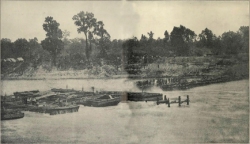
Christened “Bailey’s Dam” for the Union officer who ordered its construction, Lt.-Col. Joseph Bailey, this timber dam built by the Union Army on the Red River near Alexandria, Louisiana in May 1864 facilitated Union gunboat passage (public domain).
Having finally reached Alexandria on 26 April, they learned they would remain at their latest new camp for at least two weeks. Placed temporarily under the command of Lieutenant-Colonel Joseph Bailey, they were assigned yet again to the hard labor of fortification work, helping to erect “Bailey’s Dam,” a timber structure that enabled Union gunboats to more easily make their way back down the Red River. According to Wharton:
We were at Alexandria seventeen days, during which time the men were kept busy at throwing up earthworks, foraging and three times went out some distance to meet the enemy, but they did not make their appearance in numbers large enough for an engagement. The water in the Red river had fallen so much that it prevented the gunboats from operating with us, and kept our transports from supplying the troops with rations, (and you know soldiers, like other people, will eat) so Banks was compelled to relinquish his designs on Shreveport and fall back to the Mississippi. To do this a large dam had to be built on the falls at Alexandria to get the ironclads down the river. After a great deal labor this was accomplished and by the morning of May 13th the last one was through the shute [sic], when we bade adieu to Alexandria, marching through the town with banners flying and keeping step to the music of ‘Rally around the flag,’ and ‘When this cruel war is over.’ The next morning, at our camping place, the fleet of boats passed us, when we were informed that Alexandria had been destroyed by fire – the act of a dissatisfied citizen and several negroes. Incendiary acts were strictly forbidden in a general order the day before we left the place, and a cavalry guard was left in the rear to see the order enforced. After marching a few miles skirmishing commenced in front between the cavalry and the enemy in riflepits [sic] on the bank of the river, but they were easily driven away. When we came up we discovered their pits and places where there had been batteries planted. At this point the John Warren, an unarmed transport, on which were sick soldiers and women, was fired into and sunk, killing many and those that were not drowned taken prisoners. A tin-clad gunboat was destroyed at the same place, by which we lost a large mail. Many letters and directed envelopes were found on the bank – thrown there after the contents had been read by the unprincipled scoundrels. The inhumanity of Guerrilla bands in this department is beyond belief, and if one did not know the truth of it or saw some of their barbarities, he would write it down as the story of a ‘reliable gentleman’ or as told by an ‘intelligent contraband.’ Not satisfied with his murderous intent on unarmed transports he fires into the Hospital steamer Laurel Hill, with four hundred sick on board. This boat had the usual hospital signal floating fore and aft, yet, notwithstanding all this, and the customs of war, they fired on them, proving by this act that they are more hardened than the Indians on the frontier.
While all of this was happening, Private Lawrence Holyhauser (spelled as “Hultzheizer” on the regiment’s muster rolls) was battling disease at the Union Army’s hospital at New Orleans. He died there on 1 May 1864. Private Godfrey Betts, who had been engaged in a similar fight, died a week later.
Continuing their march, the 47th Pennsylvania Volunteers headed toward Avoyelles Parish. According to Wharton:
On Sunday, May 15, we left the river road and took a short route through the woods, saving considerable distance. The windings of Red river are so numerous that it resembles the tape-worm railroad wherewith the politicians frightened the dear people during the administration of Ritner and Stevens. – We stopped several hours in the woods to leave cavalry pass, when we moved forward and by four o’clock emerged into a large open plain where we formed in line of battle, expecting a regular engagement. The enemy, however, retired and we advanced ‘till dark, when the forces halted for the night, with orders to rest on their arms. – ‘Twas here that Banks rode through our regiment, amidst the cheers of the boys, and gave the pleasant news that Grant had defeated Lee.
Having entered Avoyelles Parish, they “rested on their arms” for the night, half-dozing without pitching their tents, but with their rifles right beside them. They were now positioned just outside of Marksville, Louisiana on the eve of the 16 May 1864 Battle of Mansura, which unfolded as follows, according to Wharton:
Early next morning we marched through Marksville into a prairie nine miles long and six wide where every preparation was made for a fight. The whole of our force was formed in line, in support of artillery in front, who commenced operations on the enemy driving him gradually from the prairie into the woods. As the enemy retreated before the heavy fire of our artillery, the infantry advanced in line until they reached Mousoula [sic], where they formed in column, taking the whole field in an attempt to flank the enemy, but their running qualities were so good that we were foiled. The maneuvring [sic] of the troops was handsomely done, and the movements was [sic] one of the finest things of the war. The fight of artillery was a steady one of five miles. The enemy merely stood that they might cover the retreat of their infantry and train under cover of their artillery. Our loss was slight. Of the rebels we could not ascertain correctly, but learned from citizens who had secreted themselves during the fight, that they had many killed and wounded, who threw them into wagons, promiscuously, and drove them off so that we could not learn their casualties. The next day we moved to Simmsport [sic] on the Achafalaya [sic] river, where a bridge was made by putting the transports side by side, which enabled the troops and train to pass safely over. – The day before we crossed the rebels attacked Smith, thinking it was but the rear guard, in which they, the graybacks, were awfully cut up, and four hundred prisoners fell into our hands. Our loss in killed and wounded was ninety. This fight was the last one of the expedition. The whole of the force is safe on the Mississippi, gunboats, transports and trains. The 16th and 17th have gone to their old commands.
It is amusing to read the statements of correspondents to papers North, concerning our movements and the losses of our army. I have it from the best source that the Federal loss from Franklin to Mansfield, and from their [sic] to this point does not exceed thirty-five hundred in killed, wounded and missing, while that of the rebels is over eight thousand.
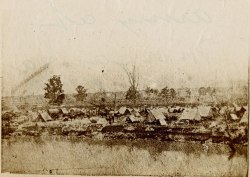
Union Army base at Morganza Bend, Louisiana, circa 1863-1865 (U.S. Library of Congress, public domain).
Continuing on, the surviving members of the 47th marched for Simmesport and then Morganza, where they made camp again. According to Wharton, the members of Company C were sent on a special mission which took them on an intense 120-mile journey:
Company C, on last Saturday was detailed by the General in command of the Division to take one hundred and eighty-seven prisoners (rebs) to New Orleans. This they done [sic] satisfactorily and returned yesterday to their regiment, ready for duty.
While encamped at Morganza, the nine formerly enslaved Black men who had enlisted with the 47th Pennsylvania in Beaufort, South Carolina (1862) and Natchitoches, Louisiana (April 1864) were officially mustered into the regiment between 20-24 June 1864. During this same time, F Company’s First Lieutenant George W. Fuller was discharged on a Surgeon’s Certificate on 22 June.
As they did during their tour through the Carolinas and Florida, the men of the 47th had battled the elements and disease, as well as the Confederate Army, in order to survive and continue to defend their nation. But the Red River Campaign’s most senior leader, Union Major-General Nathaniel P. Banks, would not. Removed from command amid the controversy regarding the Union Army’s successes and failures, he was placed on leave by President Abraham Lincoln. He later redeemed himself by spending much of his time in Washington, D.C. as a Reconstruction advocate for the people of Louisiana.
Sheridan’s 1864 Shenandoah Valley Campaign
Still able and willing to fight after their time in Bayou country, the soldiers of Company F and their fellow members of the 47th Pennsylvania returned to the Washington, D.C. area aboard the McClellan from 5-12 July 1864—but they did so without their commanding officer, Captain Henry S. Harte, who was ordered to serve on detached duty as the leader of the 47th Pennsylvanians serving with Companies B, G and K, who were left behind because the McClellan was unable to transport the entire regiment. (Captain Harte sailed later aboard the Blackstone with Companies B, G and K, and arrived in the Washington, D.C. area on 28 July.)
Also during this time, Privates Frederick Fisher and Philip McCue were discharged on Surgeons’ Certificates on 7 July, and Privates John Worley and William Herman, who had been left behind to convalesce, died at Union Army hospitals in New Orleans, Louisiana and Natchez, Mississippi on 16 and 23 July, respectively.
After arriving on the East Coast, the first group of 47th Pennsylvanians had a memorable encounter with President Abraham Lincoln, and then joined Major-General David Hunter’s forces in the Battle of Cool Spring at Snicker’s Gap, Virginia, where they assisted in defending Washington, D.C. while also helping to drive Confederate troops from Maryland.

Halltown Ridge, looking west with “old ruin of 123 on left,” where Union troops entrenched after Major-General Philip Sheridan took command of the Middle Military Division, 7 August 1864 (Thomas Dwight Biscoe, 2 August 1884, courtesy of Southern Methodist University).
Attached to the Middle Military Division, Army of the Shenandoah beginning in August, the 47th Pennsylvania Volunteer Infantry was next assigned to defensive duties in and around Halltown, Virginia in early August 1864. Over the next several weeks, the regiment engaged in a series of back-and-forth movements between Halltown, Berryville and other locations within the vicinity (Middletown, Charlestown and Winchester) as part of a “mimic war” waged by the Union forces of Major-General Philip H. Sheridan against those commanded by Confederate Lieutenant-General Jubal Early.
From 3-4 September, the 47th Pennsylvania Volunteers then fought in the Battle of Berryville.
With F Company once again under the command of Captain Harte by September, the opening days of fall 1864 saw the promotion of several men from Company F, including First Sergeant William H. Bartholomew, who was promoted to the rank of First Lieutenant on 1 September 1864, Private Benjamin F. Bush, who was promoted twice in quick succession (to Corporal on 11 September and to Sergeant on 18 September), Corporals William H. Fink and James Tait, who were promoted to the rank of Sergeant on 18 September 1864, and Private Richmond H. Schwab, who was promoted to the rank of Corporal that same day. (Private John L. Jones, who was still being held as a POW at Camp Ford in Tyler, Texas after being wounded in action and taken captive during the Battle of Pleasant Hill, Louisiana on 9 April, was also promoted that day—to the rank of Corporal.)
Mid-September also brought the departure of several 47th Pennsylvania Volunteers, however, including Second Lieutenant Augustus Eagle, who resigned on 11 September 1864, and Company D’s Captain Henry Woodruff, E Company’s Captain Charles H. Yard, and F Company’s Captain Henry S. Harte. All three mustered out at Berryville, Virginia on 18 September 1864 upon expiration of their respective three-year terms of service.
Others who mustered out with them that day at Berryville (18 September 1864) upon expiration of their own three-year service terms included: Sergeants William H. Glace, John W. Heberling, Albert H. McHose; Corporal James E. Patterson; Musician David Tombler; and Privates David Andrews, Abraham Bander, Faustin Boyer, Augustus Engle, Orlando Fuller, Joseph Geiger, Thomas B. Glick, John F. Haldeman, Joseph Heckman, Osborn Houser, Henry Hummel, William Jordan, Reuben H. Keim, Owen Kern, George King, Nicholas Kuhn, William Kuntz, J. Laudenschlager, Peter S. Levan, John Lucky, Albert Newhard, William Offhouse, Thomas B. Rhoads, Francis Roth, Gottlieb Schram, Robert M. Sheats, Llewellyn J. Sleppy, Nicholas Smith, James A. Trexler, John P. Weaver, and Gilbert Whiteman.
For the remaining members of the 47th, however, the fighting was not yet over; those still on duty were about to engage in their regiment’s greatest moments of valor.
Battles of Opequan and Fisher’s Hill, September 1864
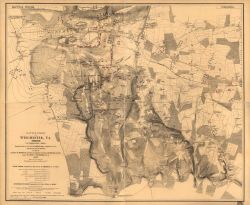
Battle of Opequan, Virginia (aka Third Winchester), 19 September 1864 (U.S. Army, public domain; click to enlarge).
Together with other regiments under the command of Union Major-General Philip H. (“Little Phil”) Sheridan and Brigadier-General William H. Emory, commander of the 19th Corps, the members of Company F and their fellow 47th Pennsylvanians helped to inflict heavy casualties on Lieutenant-General Jubal Early’s Confederate forces during the Battle of Opequan (also spelled as “Opequon” and referred to as “Third Winchester”). The battle is still considered by many historians to be one of the most important during Sheridan’s 1864 campaign; the Union’s victory here helped to ensure the reelection of President Abraham Lincoln.
The 47th Pennsylvania’s march toward destiny at Opequan began at 2 a.m. on 19 September 1864 as the regiment left camp and joined up with others in the Union’s 19th Corps. After advancing slowly from Berryville toward Winchester, the 19th Corps became bogged down for several hours by the massive movement of Union troops and supply wagons, enabling Early’s men to dig in. After finally reaching the Opequan Creek, Sheridan’s men came face to face with Early’s Confederate Army. The fighting, which began in earnest at noon, was long and brutal. The Union’s left flank (6th Corps) took a beating from Confederate artillery stationed on high ground.
Before it was all over, Private William H. Jackson was one of the members of the 47th who would give the last full measure of devotion.
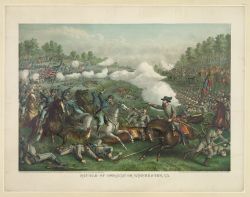
Philip Sheridan’s Union army defeating Jubal Early’s Confederate force (Kurz & Allison, circa 1893; U.S. Library of Congress, public domain).
The 47th Pennsylvania and the 19th Corps were directed by Brigadier-General Emory to attack and pursue Major-General John B. Gordon’s Confederate forces. Some success was achieved, but casualties mounted as another Confederate artillery group opened fire on Union troops trying to cross a clearing. When a nearly fatal gap began to open between the 6th and 19th Corps, Sheridan sent in units led by Brigadier-Generals Emory Upton and David A. Russell. Russell, hit twice—once in the chest, was mortally wounded. The 47th Pennsylvania opened its lines long enough to enable the Union cavalry under William Woods Averell and the foot soldiers of General George Crook to charge the Confederates’ left flank.
The 19th Corps, with the 47th in the thick of the fighting, then began pushing the Confederates back. Early’s “grays” retreated in the face of the valor displayed by Sheridan’s “blue jackets.” Leaving 2,500 wounded behind, the Rebels retreated to Fisher’s Hill, eight miles south of Winchester (21-22 September), and then to Waynesboro, following a successful early morning flanking attack by Sheridan’s Union men which outnumbered Early’s three to one. Afterward, the 47th Pennsylvania Volunteers were sent out on skirmishing parties before making camp at Cedar Creek.
Moving forward, the surviving members of the 47th Pennsylvania Volunteers would continue to distinguish themselves in battle, but they would do so without two more of their respected commanders: Colonel Tilghman Good and Good’s second-in-command, Lieutenant-Colonel George Alexander, who mustered out 23-24 September upon the expiration of their respective terms of service. Fortunately, they would be replaced with leaders who were equally respected for their front line experience and temperament, including Major John Peter Shindel Gobin, formerly of the 47th’s Company C, who had been promoted up through the regimental staff to the rank of Major (and who would be promoted again on 4 November to the rank of lieutenant-colonel and regimental commanding officer).
On 26 September 1864, Private William H. Fried was discharged on a Surgeon’s Certificate of Disability.
Battle of Cedar Creek, 19 October 1864

Alfred Waud’s 1864 sketch, “Surprise at Cedar Creek,” captured the flanking attack on the rear of Union Brigadier-General William Emory’s 19th Corps by Lieutenant-General Jubal Early’s Confederate army, and the subsequent resistance by Emory’s troops from their Union riflepits, 19 October 1864 (public domain).
It was also during the fall of 1864 that Major-General Philip Sheridan began the first of the Union’s true “scorched earth” campaigns, starving the enemy into submission by destroying Virginia’s farming infrastructure. Viewed through today’s lens of history as inhumane, the strategy claimed many innocents—civilians whose lives were cut short by their inability to find food. This same strategy, however, almost certainly contributed to the further turning of the war’s tide in the Union’s favor during the Battle of Cedar Creek on 19 October 1864. Successful throughout most of their engagement with Union forces at Cedar Creek, Early’s Confederate troops began peeling off in ever growing numbers to forage for food, thus enabling the 47th Pennsylvania and others under Sheridan’s command to rally and win the day.
From a military standpoint, it was an impressive, but heartrending day. During the morning of 19 October, Early launched a surprise attack directly on Sheridan’s Cedar Creek-encamped forces. Early’s men were able to capture Union weapons while freeing a number of Confederates who had been taken prisoner during previous battles—all while pushing seven Union divisions back. According to Bates:
When the Army of West Virginia, under Crook, was surprised and driven from its works, the Second Brigade, with the Forty-seventh on the right, was thrown into the breach to arrest the retreat…. Scarcely was it in position before the enemy came suddenly upon it, under the cover of fog. The right of the regiment was thrown back until it was almost a semi-circle. The brigade, only fifteen hundred strong, was contending against Gordon’s entire division, and was forced to retire, but, in comparative good order, exposed, as it was, to raking fire. Repeatedly forming, as it was pushed back, and making a stand at every available point, it finally succeeded in checking the enemy’s onset, when General Sheridan suddenly appeared upon the field, who ‘met his crest-fallen, shattered battalions, without a word of reproach, but joyously swinging his cap, shouted to the stragglers, as he rode rapidly past them – “Face the other way, boys! We are going back to our camp! We are going to lick them out of their boots!’”

Sheridan Rallying His Troops, Battle of Cedar Creek, Virginia, 19 October 1864 (U.S. Library of Congress, public domain).
The Union’s counterattack punched Early’s forces into submission, and the men of the 47th were commended for their heroism by General Stephen Thomas who, in 1892, was awarded the Medal of Honor for his own “distinguished conduct in a desperate hand-to-hand encounter, in which the advance of the enemy was checked” that day. Bates described the 47th’s actions as follows:
When the final grand charge was made, the regiment moved at nearly right angles with the rebel front. The brigade charged gallantly, and the entire line, making a left wheel, came down on his flank, while engaging the Sixth Corps, when he went “whirling up the valley” in confusion. In the pursuit to Fisher’s Hill, the regiment led, and upon its arrival was placed on the skirmish line, where it remained until twelve o’clock noon of the following day. The army was attacked at early dawn…no respite was given to take food until the pursuit was ended.
Once again, the casualties for the 47th were high. Sergeant William Pyers, the C Company man who had so gallantly rescued the flag at Pleasant Hill was cut down and later buried on the battlefield. Perry County resident and Regimental Chaplain William Rodrock suffered a near miss as a bullet pierced his cap. Privates Addison R. Geho and Rainey Grader of Company F were killed in action while Privates Josiah H. Walk and William H. Moll were wounded in action, but recovered and continued to fight.
Still more were captured and held as prisoners of war, several of whom died. Privates Charles H. Michael and William H. Moyer, I, of Company F were both taken prisoner by Confederate forces. Private Michael died while being held as a POW at the notorious Confederate prison camp in Salisbury, North Carolina on 11 December 1864 while Private Moyer died as a POW at the Confederate camp in Florence, South Carolina on 22 January 1865.
Following these major engagements, Edward Jassum, one of the nine Black men who had enlisted with the 47th Pennsylvania after being freed from slavery, was transferred within the regiment from Company F to Company H on 31 October.
As the fall deepened, the 47th was ordered to Camp Russell near Winchester, where it remained from November through most of December. Rested and somewhat healed, the 47th Pennsylvanians were then ordered to take on outpost and railroad guard duties at Camp Fairview in Charlestown, West Virginia.
Five days before Christmas they trudged through a snowstorm in order to reach their new home.
1865 – 1866
On New Year’s Day 1865, First Sergeant Edwin Gilbert was promoted to the rank of Captain, and Sergeant Thomas Lambert, who had joined Company F as a Private on 30 August 1861 and had worked his way up in the ranks and re-enlisted while serving at Fort Jefferson in October 1863, was promoted to Second Lieutenant. Sergeants James Tait and Richmond H. Schwab were also advanced in rank to First Sergeant, Corporal Preston M. Rohn became Sergeant Rohn, and Private Josiah H. Walk, who had been wounded during the Battle of Cedar Creek, was promoted to the rank of Corporal.
Private Joseph Gross died at the Union Army hospital in Winchester, Virginia on 17 January 1865.
Assigned in February to the Provisional Division of the 2nd Brigade of the Army of the Shenandoah, the men of the 47th moved back to Washington, D.C., via Winchester and Kernstown. On 25 February, Private John W. Crotts transferred into the 47th Pennsylvania from Company C of the 14th Pennsylvania Cavalry, as did Privates William H. Barnhart and John C. Collins (on 18 March).
Despite this period of relative calm, casualties still occurred. On 25 March, Private Harrison Lilly was killed at Summit Point, Virginia while Corporal Franklin Arnold was wounded there three days later on 28 March. And Private Arnold would ultimately be discharged on a Surgeon’s Certificate less than four months later on 15 July 1865.
More roster changes occurred on 2 April 1865 when Privates G. H. Longenhagen, Martin O’Brien and Spencer Tettemer were all promoted to the rank of Corporal, and on 15 April 1865 when Sergeant William H. Fink died at the Union Army hospital in Baltimore, Maryland.
That same day (15 April 1865), the 47th Pennsylvania Volunteers received confirmation that President Lincoln had died from the gunshot wound he had sustained during an assassination attempt the night before at Ford’s Theatre. Multiple letters and diary entries penned by members of the 47th during this period convey their shock, intense grief, and anger.
By 19 April, the 47th Pennsylvania Volunteers were responsible, once again, for helping to defend the nation’s capital—this time, to prevent the dying embers of civil war from flaring back up in the wake of Lincoln’s murder. Encamped near Fort Stevens, they received new uniforms and were resupplied.
On 21 April, Corporal Joseph Lilly became Sergeant Lilly. Private James M. Bush became Corporal Bush four days later on 25 April when Corporal Joseph H. Schwab was discharged on a Surgeon’s Certificate that day.
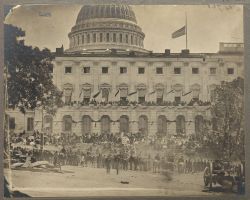
Spectators gather for the Grand Review of the Armies, 23-24 May 1865, at the side of the crepe-draped U.S. Capitol, flag at half-mast following the assassination of President Abraham Lincoln (Matthew Brady, U.S. Library of Congress, public domain).
Letters home and later newspaper interviews with survivors of the 47th Pennsylvania indicate that at least one 47th Pennsylvania Volunteer, Samuel Pyers, was given the high honor of guarding President Lincoln’s funeral train while others may have guarded the Lincoln assassination conspirators during the early days of their imprisonment.
As part of Dwight’s Division of the 2nd Brigade of the Department of Washington’s 22nd Corps, the 47th Pennsylvania also participated in the Union’s Grand Review on 23-24 May. On 25 May, Private Joel Michael, who had transferred into the 47th Pennsylvania from the 159th Pennsylvania Volunteers, was discharged on a Surgeon’s Certificate, as was Private Michael O’Brien.
Captain Levi Stuber of Company I also advanced to the rank of Major with the regiment’s central staff during this time.
Substitute Privates Alfred Biege, Michael Deibert, John G. Snyder, and Franklin H. Wilson were mustered out by General Order of the U.S. War Department on 1 June 1865, as were Privates Charles King (alternate spelling of surname: Koenig), Charles Rohrbacher and Peter Shireman. Sometime during his term of service, Private Charles King sustained a gunshot wound to his left shoulder.
Private James M. White, who had transferred from the 14 Pennsylvania Cavalry to the 47th Pennsylvania Volunteers on 12 March 1865, was discharged on a Surgeon’s Certificate on 25 June.

Ruins of Charleston, South Carolina as seen from the Circular Church, 1865 (U.S. National Archives and Records Administration, public domain).
On their final southern tour, the remaining men of Company F and their fellow members of the 47th Pennsylvania served in Savannah, Georgia from 31 May to 4 June. Attached again to Dwight’s Division, this time they were with the 3rd Brigade, Department of the South. Corporal John L. Jones, who had been wounded in action during the Battle of Pleasant Hill, Louisiana on 9 April 1864 and promoted from the rank of Private while being held as a POW at Camp Ford in Tyler, Texas, was promoted again—this time as a free man. He became a Sergeant on 2 June 1865. Privates Robert Cunningham and Walter Moyer were also both promoted that day to the rank of Corporal.
Relieving the 165th New York Volunteers in July, the 47th Pennsylvania Volunteers next quartered in Charleston at the former mansion of the Confederate Secretary of the Treasury.
Privates Adam Wuchter and Jefferson Kepner were mustered out by General Order of the U.S. War Department on 24 July and 11 August, respectively. Private David A. Fry died at the Union Army hospital in Charleston just five days later—on 16 August.
Private George Armsberg, who had been a Cavalry transfer to the 47th, was then discharged on 6 September, followed by Abraham Jassum, another of the nine Black men who had enlisted with the 47th Pennsylvania after being freed from slavery. Jassum was honorably discharged on 4 October 1865 upon completion of his three-year term of enlistment.
Private Alfred Lynn was then awarded a Surgeon’s Certificate discharge on 14 October.
Those departures were then followed by those of Corporal James M. Bush and Private John Markoffer on 16 and 28 October, upon expiration of their respective three-year terms of service, Privates Philip King and Sidney J. Miller, on 14 November and, on 9 December, Private Daniel A. Ackroth, who had transferred into the 47th with Armsberg.
Finally, beginning on Christmas Day of that year, the remaining members of Company F, 47th Pennsylvania Veteran Volunteers began to honorably muster out with their regiment in Charleston, South Carolina—a process which continued through early January. Following a stormy voyage home, the 47th Pennsylvania disembarked in New York City. The weary men were then shipped to Philadelphia by train where, at Camp Cadwalader on 9 January 1866, they were given their final discharge papers.
Their war was now officially over.
Sources:
1. Bates, Samuel P. History of Pennsylvania Volunteers, 1861-5, vol. 1. Harrisburg, Pennsylvania: B. Singerly, State Printer, 1869.
2. Burial Ledgers, in Record Group 15, The National Cemetery Administration, and Record Group 92, U.S. Departments of Defense and Army (Quartermaster General). Washington, D.C.: U.S. National Archives and Records Administration, 1861-1865.
3. Civil War Muster Rolls, in Records of the Department of Military and Veterans’ Affairs (Record Group 19, Series 19.11). Harrisburg, Pennsylvania: Pennsylvania Historical and Museum Commission.
4. Civil War Veterans’ Card File. Harrisburg, Pennsylvania: Pennsylvania State Archives.
5. Claims for Widow and Minor Pensions, in U.S. Civil War Widows’ Pension Files. Washington, D.C.: U.S. National Archives and Records Administration.
6. “Death of Capt. Harte, of Catasauqua” (obituary and death notice). Allentown, Pennsylvania: The Allentown Democrat, 10 August 1881.
7. “Florida’s Role in the Civil War,” in Florida Memory. Tallahassee, Florida: State Archives of Florida.
8. Historic Pennsylvania Church and Town Records (baptismal, marriage, death and burial records of various churches across Pennsylvania). Philadelphia, Pennsylvania: Historical Society of Pennsylvania.
9. Interment Control Forms, in Record Group 92, U.S. Office of the Quartermaster General (Record Group 92). College Park, Maryland: U.S. National Archives and Records Administration.
10. Pennsylvania Veterans’ Burial Index Cards. Harrisburg, Pennsylvania: Pennsylvania Department of Military and Veterans Affairs.
11. Registers of Deaths of Volunteers, in Records of the U.S. Adjutant General’s Office. Washington, D.C.: U.S. National Archives and Records Administration, 1861-1865.
12. Schmidt, Lewis. A Civil War History of the 47th Regiment of Pennsylvania Veteran Volunteers. Allentown, Pennsylvania: Self-published, 1986.
13. Stegall, Joel T. “Salisbury Prison: North Carolina’s Andersonville.” Fayetteville, North Carolina: North Carolina Civil War & Reconstruction History Center, 13 September 2018.
14. “Tamiami Trail Modifications: Next Steps,” in Draft Environmental Impact Statement. Washington, D.C. and Everglades National Park, Florida: U.S. National Park Service, 2010.


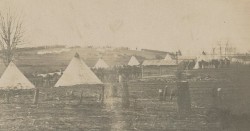




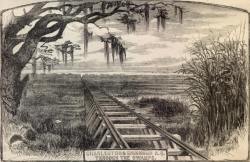
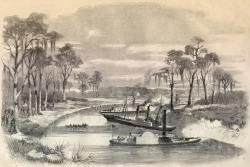

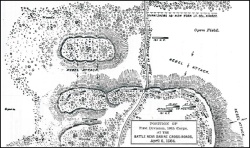
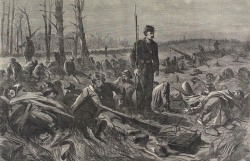
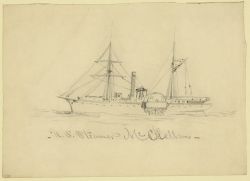
You must be logged in to post a comment.